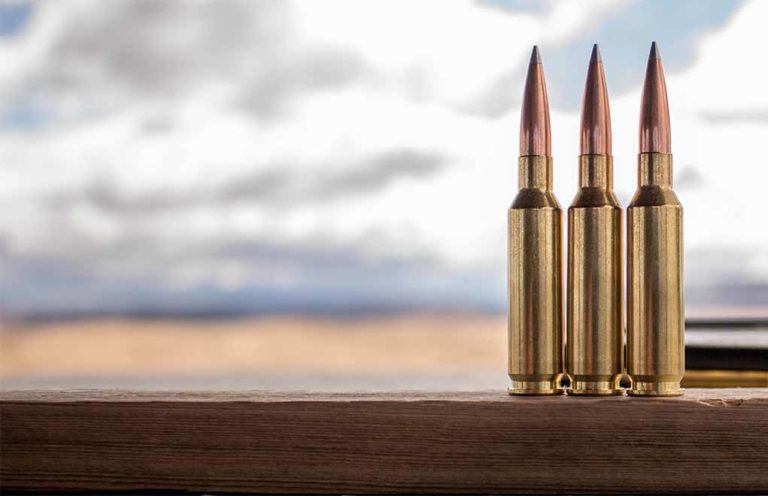
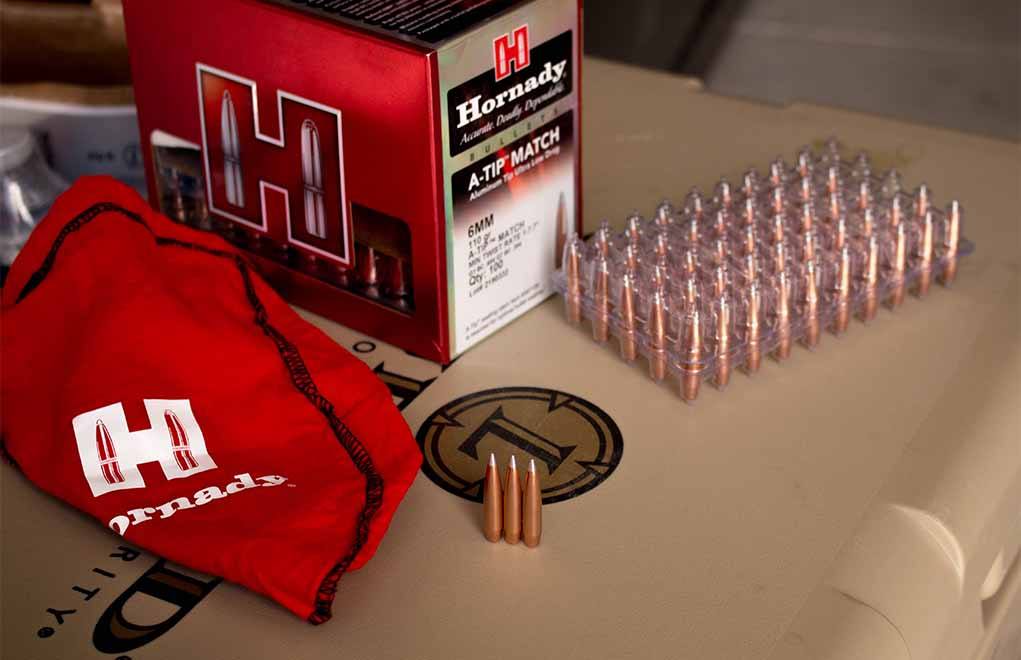
Boasting uniform aluminum tips, does the Hornady A-Tip represent the next big advancement in long-range bullets?
What Makes The A-Tip A Cut Above Other Match Bullets:
- Machined aluminum tips kept to very tight tolerances.
- Bullets maintain their intended shape in flight.
- Center of gravity shifted for optimum stability.
- AMP bullet jacket modified for seamless tip/ogive transition.
- Bullets are packaged sequentially, right off the press, for utmost consistency per batch.
“Dial 14.8 mils elevation and hold a full 4 mils left for wind.”
So came the instruction from Kyle Lynch, a fellow gun writer and my partner for some shooter/spotter exercises we were participating in at the Leupold Optics Academy.
I spun the elevation turret of the scope and backed off just a bit on the magnification to remove some of the mirage, holding on the 4-mil hash in the horizontal bar, and broke the trigger on the Ruger Precision rifle. It took a couple of seconds or so for the bullet to get to the steel, but the splatter at the center of the orange dot of the 1,500-yard steel was extremely gratifying, considering the wind, which was gusting to 20 mph on the Oregon high desert. Living in the Northeast, I don’t have a lot of opportunity to take things out very far, so when I do get a chance, I jump at it.

This particular event saw Leupold pair with Hornady, which has recently announced the release of its newest match bullet: the A-Tip. Using a machined aluminum tip in place of a traditional hollow-point or polymer tip, the A-Tip bullet just might be the next big advancement in long-range bullet technology.
Rocket Science
As the Hornady website states, “Yes, it is rocket science!” The company’s R&D team put forth a huge effort in manufacturing the best match bullet it could create—a tall order, considering the field-proven success of the Hornady ELD-Match bullet.
Using an aluminum tip is not a new idea; Hornady has used it before (on its National Match line, it employed a seriously large aluminum tip. And the original Winchester SilverTip line used a flat aluminum cap over a cup-and-core bullet in an attempt to mitigate premature bullet breakup, which sort of worked). Neither of these bullets has the silky-smooth transition of aluminum tip to copper jacket, nor does it hold the tolerances that the Hornady A-Tip holds.
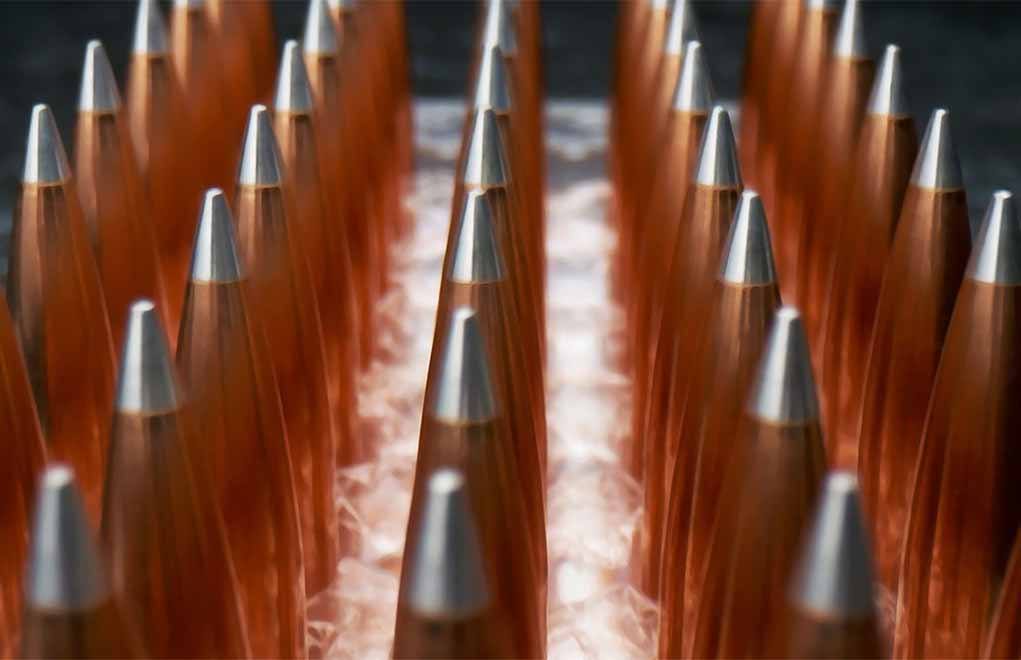
Hornady chose aluminum for a meplat material for a number of reasons. Firstly, it’s capable of being manufactured to very tight tolerances, and it’s equally capable of maintaining the intended shape. As we all know, uniformity is a very important part of the accuracy equation, and the meplat of a bullet can have a drastic effect on its resistance to atmospheric drag. Now, it should be blatantly obvious that machining a tip for each bullet is not exactly cost-effective; or maybe it’s better said that the process and the material will add to the cost of the A-Tip bullet.
Load Up More Ammo Info:
- 14 Red-Hot 6.5 Creedmoor Ammunition Options (2019)
- 11 Videos To Get You On Track Reloading Ammunition
- .224 Valkyrie: A Small Fry With Legs
- AR-15 Calibers And Cartridges: What Should You Chamber Your Carbine?
- Bullet Expansion: Velocity Is The Deciding Factor
Secondly, Hornady uses the shape and weight of the tip to purposefully shift the center of gravity to the location the company desired for optimum stability. The tip is certainly long—long enough to require a special seating plug, which Hornady offers for sale for its dies—and it’s quite obviously consistent, as you’ll find out in a bit. Hornady has engineered the A-Tip from the ground up: It’s much more than just an aluminum tip on an existing bullet profile. The company is offering a truly unique experience for those in pursuit of the finest accuracy … or better yet, precision.
A Slight Digression
Hornady has modified/improved its AMP bullet jacket for the new A-Tip bullet, and the results are pretty obvious once you start putting them downrange. A sleek ogive and long boat tail complement the design, giving the bullet a very high BC (ballistic coefficient) value; speaking of which, perhaps a bit of discussion regarding “ballistic coefficient” is warranted, considering Hornady’s attitude regarding that term.
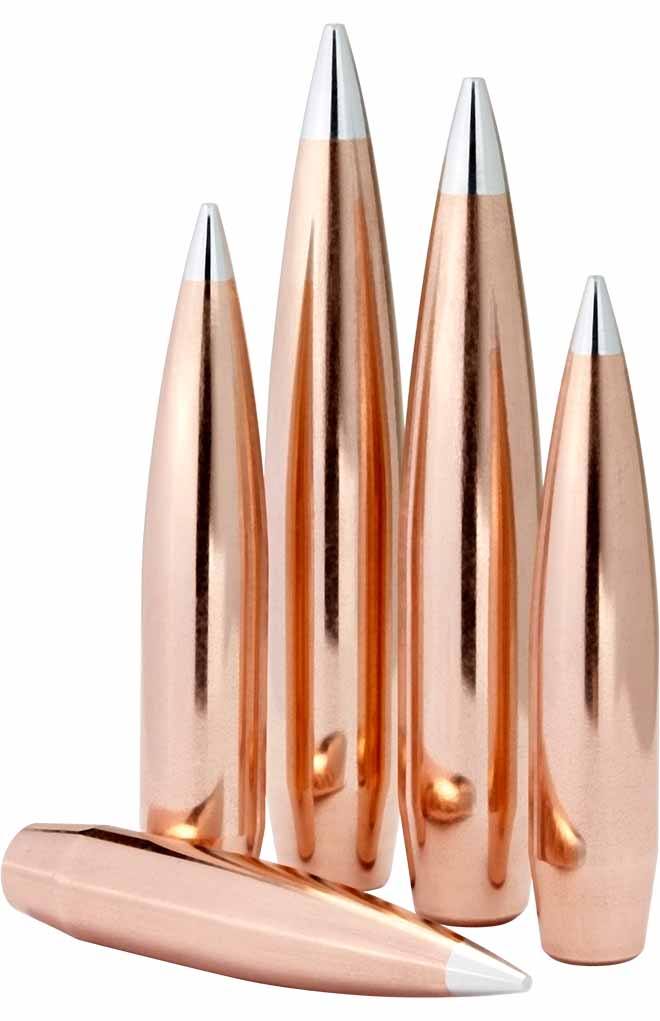
Ballistic coefficient is a unit-less number that uses the bullet’s sectional density, mass and coefficient of form to compare it to a specific model. Most times, it’s the G1 or G7 models for our rifle bullets. While this method is certainly a useful application in predicting trajectory curves, it most certainly has its flaws, because BC is a fluid number and can, and most certainly will, change with varying velocities. Sometimes, a bullet’s BC is averaged across a wide spectrum of velocities; and sometimes, those numbers can be slanted to give a better impression of a bullet’s performance.
For example, the G1 figures for any bullet will certainly be more attractive than the G7 values, even though the G7 values are more than likely closer to the truth. Even without leaning toward a higher velocity range in order to slightly inflate numbers, Hornady seems to be drifting away from BC, because its 4 Degrees of Freedom (4DOF) ballistic program relies on a bullet’s axial form factor rather than on BC.
Axial Form Factor in the Real World
The 4DOF program is a good one and was a real eye-opener to me on the shoot in Oregon. We were using rifles chambered in 6.5 Creedmoor with ammunition handloaded by the good folks at Hornady (you see, the A-Tip bullets are only available in component form) and looking through excellent Leupold glass, so that eliminated any excuses.
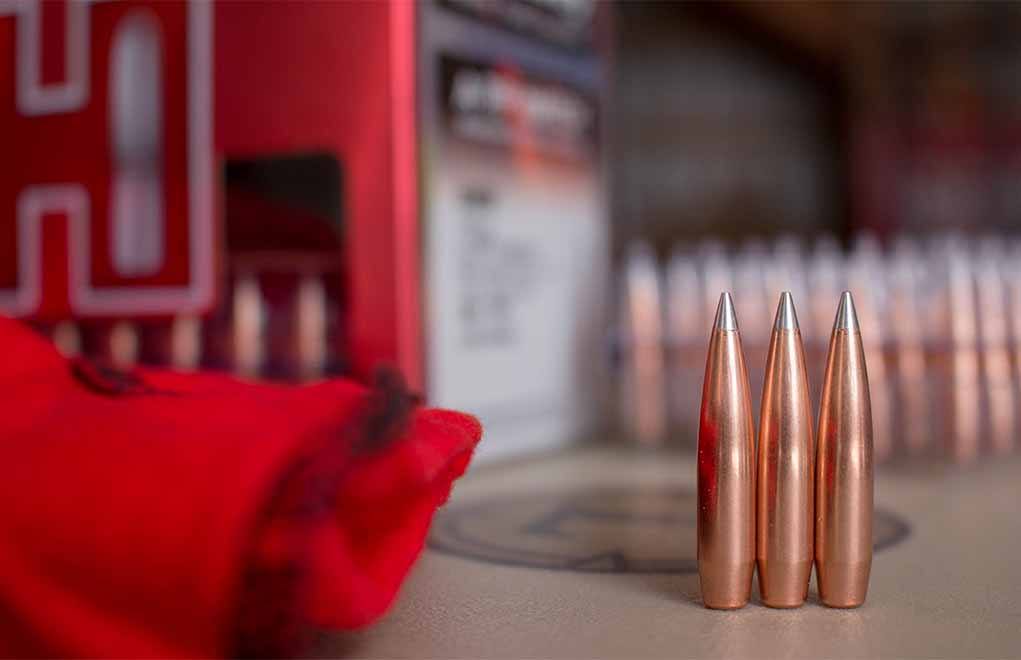
We took the environmental data, including elevation above sea level, temperature and humidity, and measured the muzzle velocity of the rifle. After zeroing at 100 yards, we then took the measurement of the elevation of a five-shot group at a target at 577 yards (this distance can be any arbitrary distance, but a target between 500 and 750 yards usually produces the best results) and adjusted the trajectory curve by taking some percentage of the modeled axial form factor.
Because my rifle was running a bit hotter than some others—it was pushing the 135-grain A-Tip to a muzzle velocity of 2,769 fps on the LabRadar—I needed a lower percentage. Nonetheless, once all was plugged into the program, Kyle and I were seeing consistent hits out to 1,500 yards, with the wind calls being the only serious challenge.
The shooting range at Madras, Oregon, was slightly more than 2,000 feet above sea level; the air was certainly on the dry side (making for thicker air); and the temperatures were mild (between the high 60s and mid-70s). However, once I crunched the numbers for the 6.5 Creedmoor with the 135-grain A-Tip, I quickly took note of the fact that the particular rifle I was shooting would have the bullet stay supersonic just over the one-mile mark. The Creedmoor is no speed demon, and that performance is a testament to the A-Tip and the way it maintains energy downrange.
Made for Long-Range Work
Hornady has taken a unique approach to packaging this new bullet. Instead of a simple bulk packaging, Hornady has decided to give reloaders the least invasive treatment possible: The A-Tip bullets are packaged sequentially, right off the press, without cleaning off any excess lubricant or anything else.
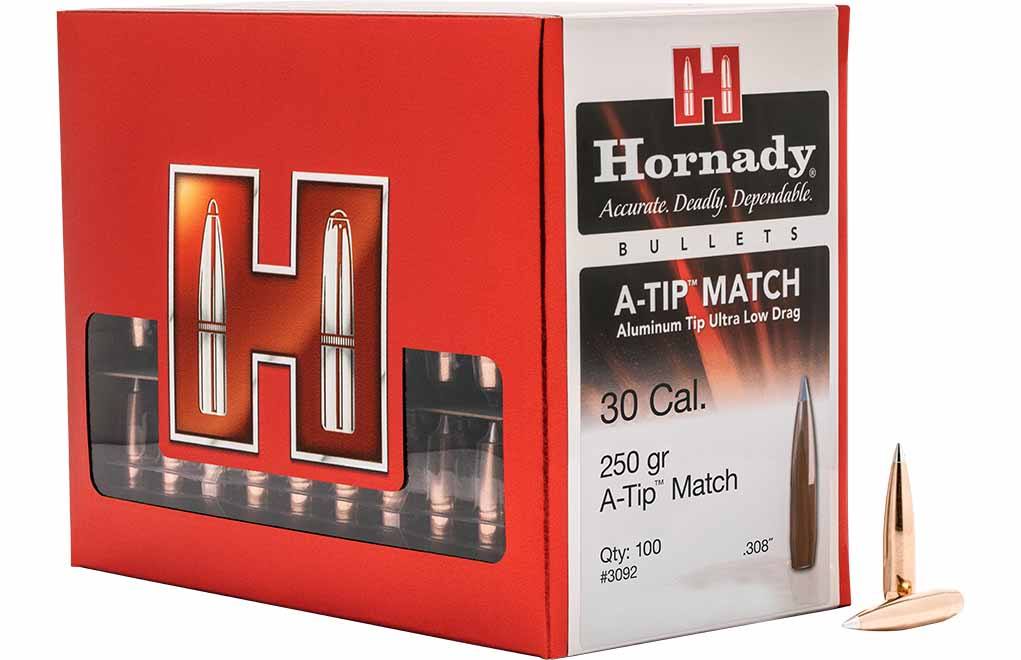
When you buy a box of 100 bullets, you get 100 bullets just as they come off the press, in order; and Hornady will offer the sequential deal for up to 1,000 bullets. This process helps minimize the need for bullet sorting, whether by weight or base-to-ogive dimension, by giving the consumer the most consistent product available.
Included in each package is a polishing bag (it resembles a Crown Royal bag, but it’s in Hornady red, with the big “H” logo embroidered on it). This allows the user to clean the lubricant off the bullets just a few at a time. How this might translate to loaded ammunition, I don’t know, but I’d bet Hornady will find a way (Hornady has insisted that no imminent plans for loaded ammunition exist).
Regarding construction, Hornady feels that the lead core/copper jacket combination makes a better choice for the quintessential target bullet than does a homogenous alloy, because it can better control the parameters of the bullet and develop a more uniform product than even the lathe-turned designs. Having worked with a good number of bullet designs over the years, I can attest that the Hornady A-Tip grabbed my attention right away, because that tip/ogive transition is nearly seamless.
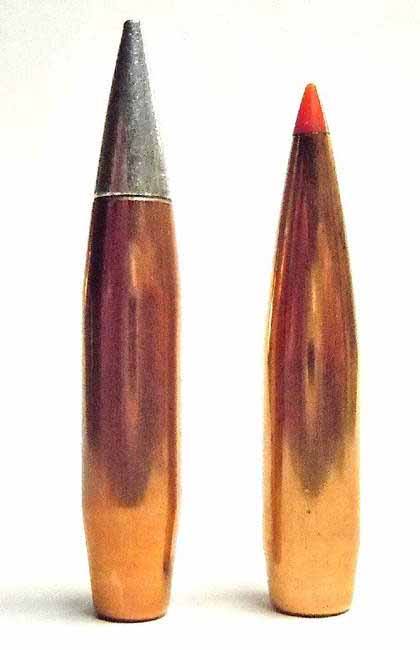
The initial release of the A-Tip shows three calibers and five models, and I’ll include the listed BC values as a comparison to other bullets: the 110-grain, 6mm bullet (G1 .604 and G7 .304); 135-grain, 6.5mm bullet (G1 .637 and G7 .321); 153-grain, 6.5mm bullet (G1 .704 and G7 .355); 230-grain, .308-inch bullet (G1 .823 and G7 .414); and finally, the 250-grain, .308-inch bullet (G1 .878 and G7 .442). All are on the heavier end of spectrum, especially the 230- and 250-grain .30-caliber bullets—with the exception of the 6.5mm, 135-grain bullet, and that gave stellar performance.
As you might have deduced, these bullets are designed for long-range target work; Hornady has indicated that it hasn’t taken terminal ballistics into account at all with the A-Tip, and it doesn’t recommend it for hunting.
I can attest to its long-range capabilities. And although the Ruger Precision rifle is recognized as a good value, it is certainly not a custom rifle. Yet, the Hornady A-Tip might have you wondering if you need one.
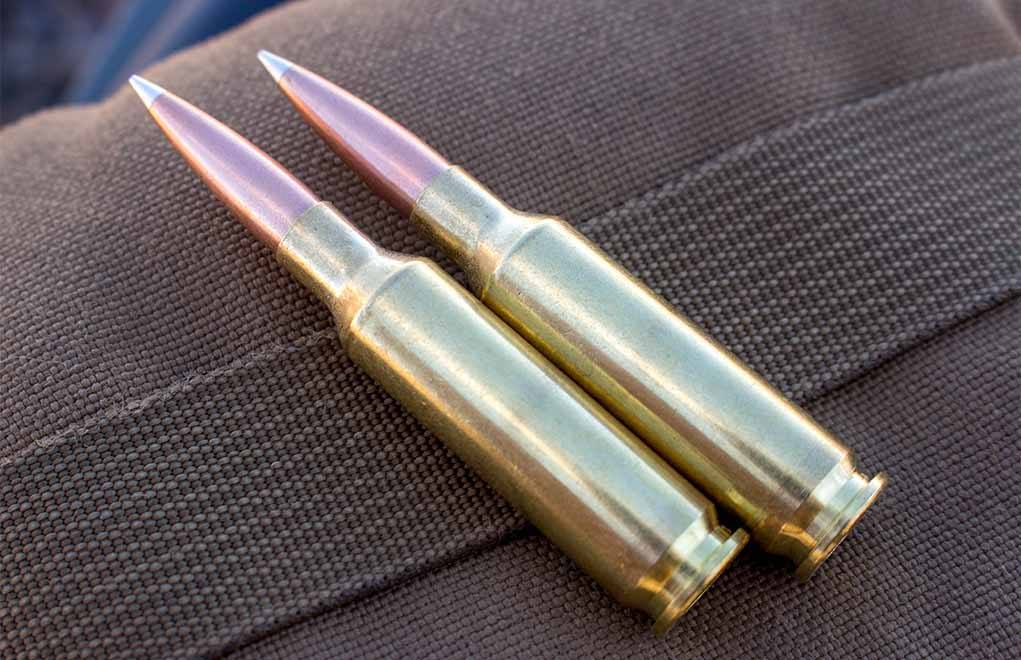
I am a firm believer that a bullet of this shape and length needs a bit of time (or distance, depending on how you look at it) to settle down, and the A-Tip gave me better accuracy at 300 yards than it did at 100 yards, settling down from 1 MOA at 100 to ½ MOA at 300.
I can easily see the 110-grain, 6mm mated with the 6mm Dasher, 6XC and 6mm Creedmoor; and that 153-grain, 6.5mm is certainly going to see duty in my 6.5-284 Norma—not to mention the 6.5 PRC. I think the 230-grain A-Tip might be squeezed into the .300 Winchester Magnum case, but more than likely, both it and the 250-grain A-Tip will be at home in the .300 PRC and the .300 Norma Magnum.
In a sit-down with Hornady Marketing Director Neil Davies, I inquired about future developments of the A-Tip line … perhaps a .338-inch offering or a modification of a 165- or 168-grain A-Tip for the .308 Winchester. In true professional fashion, Neil would neither confirm nor deny these future offerings.
The cost of the manufacturing process is reflected in the price of the A-Tip bullets, with street prices running between $80 and $90 per box of 100 bullets. However, if you take accuracy and the various rifle competitions seriously, this is a small price to pay for this level of performance. At the very least, the Hornady A-Tip will help push the boundaries of match bullet design, but I suspect that the A-Tip will become a new benchmark in bullet performance.
The article originally appeared in the 2019 Long-Range Shooting issue of Gun Digest the Magazine.

Next Step: Get your FREE Printable Target Pack
Enhance your shooting precision with our 62 MOA Targets, perfect for rifles and handguns. Crafted in collaboration with Storm Tactical for accuracy and versatility.
Subscribe to the Gun Digest email newsletter and get your downloadable target pack sent straight to your inbox. Stay updated with the latest firearms info in the industry.

![Best Concealed Carry Guns In 2025 [Field Tested] Wilson Combat EDC X9S 1](https://gundigest.com/wp-content/uploads/Wilson-Combat-EDC-X9S-1-324x160.jpg)


![Best 9mm Carbine: Affordable PCCs [Tested] Ruger Carbine Shooting](https://gundigest.com/wp-content/uploads/Ruger-Carbine-Shooting-100x70.jpg)
![Best AR-15: Top Options Available Today [Field Tested] Harrington and Richardson PSA XM177E2 feature](https://gundigest.com/wp-content/uploads/Harrington-and-Richardson-PSA-XM177E2-feature-100x70.jpg)
